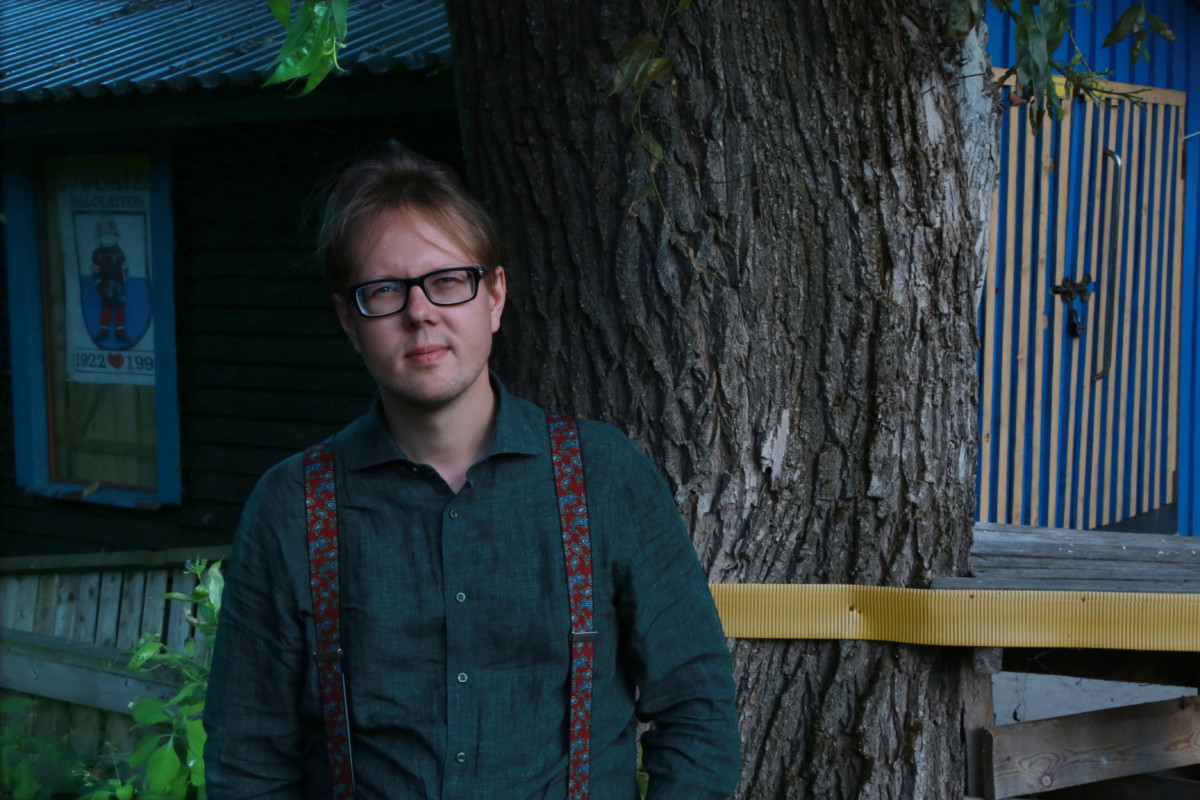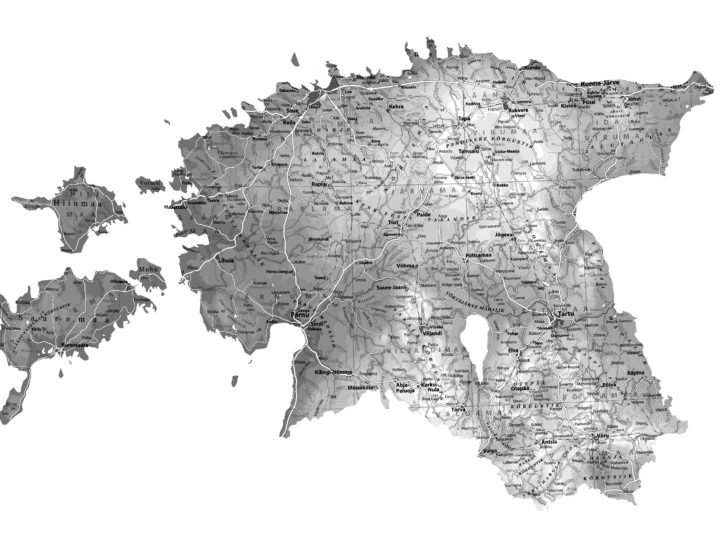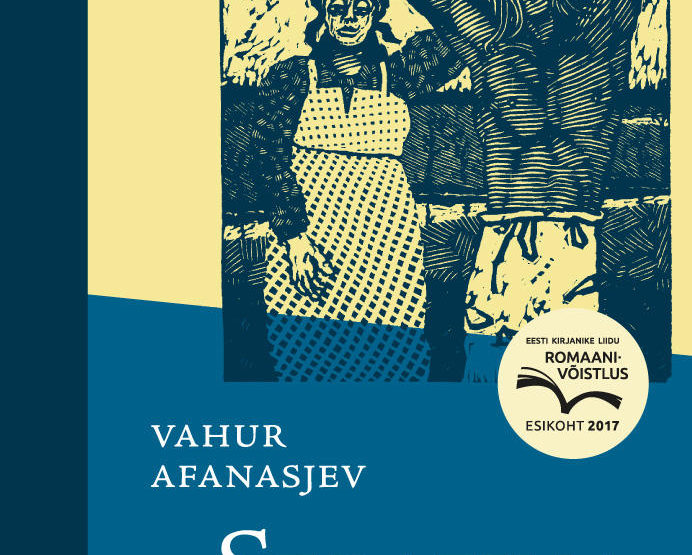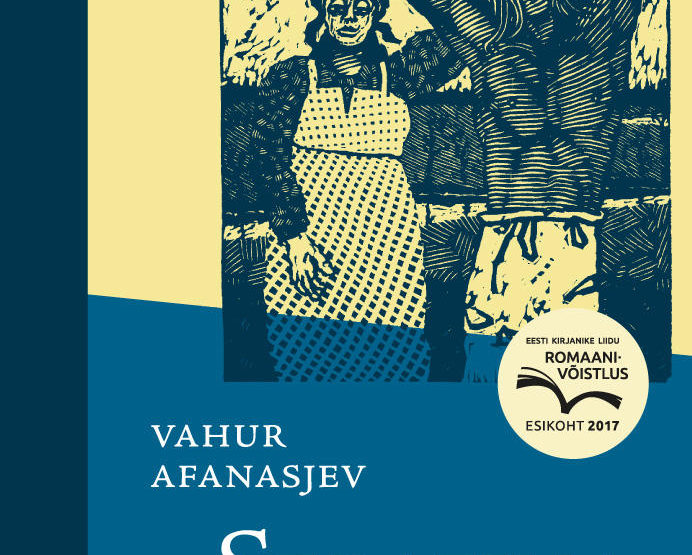Vahur Afanasjev is a multifaceted man who has written poetry as well as prose, produced films, performed music, and dabbled in many other creative arts. Time and again, these activities have landed him in Estonia’s spotlight. Yet when his novel Serafima and Bogdan was published last year, it became resoundingly clear that Afanasjev is a writer above all – and a fantastic one at that. The novel first won the Estonian Writers’ Union’s Novel Competition and then, this spring, received the most esteemed local literary prize: the Cultural Endowment of Estonia’s Award for Prose. To top it off, the work has been highly acclaimed and is currently being translated into English for publishing in the UK. Serafima and Bogdan is a pan-generational story about the lives of Russian Orthodox Old Believers inhabiting the western shore of Lake Peipus. It endeavors to determine the driving forces behind revenge and violence, as well as to comprehend what man’s role is here on earth.
You have quite a long literary path behind you and received recognition for your writing long before Serafima and Bogdan. Perhaps you could talk, first of all, about your background and your writing: what points in your career seem most important to you, personally?
My father was a mathematician, but he loved to read, and our walls were filled with shelves upon shelves of books. My maternal grandmother, who would come to look after me, read me fantastic works such as Selma Lagerlöf’s The Wonderful Adventures of Nils. I remember being struck by the idea to start writing books even before I really knew how to read or write. My first book was going to be about aliens and eggs. I haven’t written it yet. My grandmother, by the way, wrote many of her own lyrics to songs, such as “Seal kus rukkiväli” (“On the Banks of the Wabash, Far Away”) and “Kaugel, kaugel, kus on minu kodu” (“Red River Valley”). The lyrics were akin to popular Estonian-language translations, or “fan lyrics”, as we would say nowadays.
I wrote my first poems as a teenager, inspired by the Estonian band Vennaskond, led by Tõnu Trubetsky: an anarchist and a romantic poet. Using poems as lyrics is common practice in Estonia; much more common than in the West. Although I’ve mostly written free-verse poetry in my adult years, I still always hear it rhythmically in my head, like it’s part of music. Actually, music is what feeds my prose, giving it a shade of emotion. Music is physical; is pure emotion; is the electricity of a text machine.
My poems were first published in the Estonian literary journal Vikerkaar in 1998, twenty years ago – it amazes me that my life already has that kind of a dimension. I joined the Noorte Autorite Koondis [NAK, Young Authors’ Society], which was simultaneously a group and a club for creative persons. There, I met the best daughters and sons of Estonian literature. It’s important for one to find allies. We didn’t discuss each other’s writing, didn’t hold creative-writing seminars or involve ourselves in any other crap like that, but rather talked to one another; partied, and learned how to perform so we would be heard.
In 2000, I used a student loan to print my poetry collection Kandiline maailm (Square World). I suppose I hoped I’d become famous right away. Estonia is tiny and some people have gotten famous like that – newspapers and literary magazines would publish a review or mention them. It’d be a big thing in a big country. And then came years of constant work, which the modest recognition – given by a tight circle – encouraged me to continue. This led to receiving the Cultural Endowment of Estonia’s Award for Poetry and wider fame for my 2015 collection Tünsamäe tigu (The Snail of South Estonia).
There’s this idea in a Janusz Glowacki play: in order to change an intellectual’s mind, it’s enough to ask him “Are you sure?” I suppose I’m not an intellectual in that sense, because I kept writing – poetry collections, short stories, and shorter novels. Throughout that time, I worked in the fields of journalism, advertising, and public administration. I tried out the stock markets; I was in a casting agency and a couple of start-ups. I lived in Brussels for five years working in an EU institution. Well, Kurt Vonnegut sold cars, and they say he was the first importer of SAAB to the US.
Serafima and Bogdan has entranced many readers through its field of focus. You deliver a miniscule nation in all its glory to Estonian literature. One that locals all know exists, but which has rarely been represented in Estonian literature, and even then only in the form of secondary or background characters. The Russian Old Believers, or as Estonians call them the “Peipus Russians”, have lived on the western shore of Lake Peipus for centuries. Residing here, they have formed their own identity; one so strong that they have their own word for the Russians who moved to Estonia’s territory later: rusmannny (I even found that out from your novel). The life and times of these Old Believers, primarily during the period 1944–1987, comes to life through your pen in this book. Could you characterize the situation of these people in Estonia more generally? What could a reader know about the Lake Peipus Old Believers prior to opening up Serafima and Bogdan?
The Orthodox Russian Old Believers living along Lake Peipus are an archaic, culturally Russian minority that formed in the 17th century with the beginning of the centralization of the Russian state and Church. Some decided to remain true to the old customs, fleeing to the periphery of the tsardom and to neighboring countries; some even to America. These religious refugees entering Estonia, settled somewhat sparsely along Lake Peipus, as a result there were no great clashes with the Estonian-speaking natives. Although the population was initially extremely religious, they were not an expansive majority. I can’t imagine Old Believer missionaries going door-to-door or turning Europe into their own “caliphate”.
The Soviet era exterminated Old Believers’ traditions from their everyday life, but a thrilling genius loci still exists: a breath of old Russia from the time before Peter the Great, perhaps even of Andrei Rublev. Estonia is situated at the border of the European Union, even at the border between East and West. Eras, in addition to cultures, mingle along the coast of Lake Peipus, but one doesn’t need to know that beforehand and can simply garner the knowledge from the book in peace.
Scattered along Lake Peipus’ shoreline is a population with truly diverse backgrounds: far from all of them are Old Believers, and just like with Protestants, there are several different kinds. Our neighbors were Pomors who were much milder than the Fedoseyevians in terms of religion: the latter don’t recognize marriage, for example. If a Fedoseyevian Old Believer enters an earthly marital union, then the person is not excommunicated, but the congregation determines a symbolic punishment for the couple. As an interesting parallel, in America, a land of immigrants, the scale of Protestantism is much more mottled: you have Seventh-Day Adventists, Methodists, Presbyterians, Calvinists, ordinary Protestants, and Anabaptists. The attempts to convert Old Believers would be a topic for a novel of its own. In addition to the Moscow and Constantinople patriarchates, all kinds of brotherhoods and Pentecostalists all the way up to Jehovah’s Witnesses have given it a try (quite unsuccessfully, I might add). Only the Communists pulled off their conversion, and so much so that they left only a brush-choked clearing in place of a religion.
Now, I’d like to touch on the topic of you and the Old Believers. I understand that despite your Russian last name, you yourself have no ancestral ties to the Old Believers. How did the topic come into your life and how much additional material about the Old Believers did you have to look up when writing the book?
My parents bought a cabin in an Old Believer village in the early 1980s. I spent summers there, playing with the local kids and listening to what the adults talked about. All our neighbors had icon corners, grew onions, drank tea from saucers, and their Russian was different from the Russian taught at school; the adult women kept their hair covered. I suppose it was only once I was living in Brussels that I realized what a unique environment I was acquainted with.
To write my novel, I read books about the Old Believers and the people living along Lake Peipus. There weren’t a whole lot of them, but I also combed carefully through the internet. There’s an astounding wealth of information written – both in Estonian and in Russian – about their village celebrations, the Red Terror, the founding of the kolkhoz farm system, Stalin’s death, shop goods, the healthcare system, their dress, their methods for fishing, and even how they went swimming. Luckily, I can read Russian, so there were exponentially more sources than I’d have found about the era and the Soviet empire with only the Estonian or English languages at my disposal. The research helped me organize my knowledge, but I couldn’t have written a book like this without direct experience. Even though it’s thick, I recorded far from everything.
One of the most important parts of the Old-Believer identity is religiosity. Consequently, great attention is dealt to the characters’ religious experiences and practices. It is testament to religion’s importance in your book that you’ve added a snippet from scripture to every chapter. It’s not hard to pick out the references you made to sacred texts when titling the novel’s sections: “The Book of Weddings”, “The Book of Survival”, “The Book of Growth”, etc. What’s more, the fact that any type of religion at all was officially ostracized and condemned during the Soviet era leaves its stamp on the whole sphere. How difficult was it for you to revive that atmosphere interlaced with religion? During the 1980s, back when you were spending time at your parents’ summer cabin in a village on the shore of Lake Peipus, how perceivable was the nearby Old Believers’ relationship to religion?
The primary generation of the late 1920s and early 1930s at the center of the plot of Serafima and Bogdan was alive and well back then. They made the sign of the cross, lit candles in front of icons in the corner of their houses, and knew the religious holidays. As a child, I didn’t give any thought to the religious background, of course. And they behaved oddly. For instance, the neighbors earned a sizeable supplement to their kolkhoz salaries by selling cucumbers and onions, but didn’t build a bigger house or significantly improve their living conditions with it. They carried water in from the well in a pail, an outhouse was back by the shed, and a waste bucket reeked in the corner, but at the same time, a state of absolute cleanliness governed indoors. Little houses, modest living conditions – their attitude wasn’t to take and demand more of life; bigger, more colorful. If God delivered, then he delivered.
Socialism had partially elbowed its way in in place of God. People also weren’t responsible, nor were they permitted responsibility for their own lives. Up until World War II, religion had more or less kept the Old Believer population’s hedonism in check. When the kolkhoz system was put in place, people started drinking and behaved more carelessly with nature and animals. The younger the person, the worse he behaved. Even as a child, the difference was obvious to me.
In my opinion, socialism was more devastating to the Old Believers along Lake Peipus than it was to inland Estonians, particularly because of the lack of responsibility they were accustomed to. Protestant or unreligious Estonians were used to getting by on their own; the collapse of the socialist system didn’t affect them as severely. The shore of Lake Peipus, on the other hand, was suddenly deprived of both God and the state’s suckling teat. Society and the economy don’t work effectively when populations are kept like sheep. The destruction of Socialism was a natural process across the entire Soviet Union.
Rebirth, resurrection, nirvana – religion offers many opportunities to believe there’s something greater, something more beautiful, something purer than man. That something lies beyond earthly life and human intelligence, but at the same time is something towards which one can advance and, perhaps, even reach if he tries hard enough. Still, the person is most important of all. Me, my loved ones, the place I live in, my nation, and people all around the world with similar interests or fates. According to Buddhism, everything is emptiness. Still, even if I’m an illusion or a program on a hard drive like in a Stanislaw Lem novella, I still perceive my existence. Intensely. With every cell of my being. There’s no sign of reincarnation or nonexistence in the perceivable world. I have one life and one death. It’s a heavy thought, but it makes it that much clearer how much you must care for yourself and others.
I myself have also written a few works of historical fiction about Estonia’s hard times in the mid-20th century and later. My experience tells me there’s a big difference between writing about your own lifetime (even a small child can vividly remember many details that are true to the era) and writing about years that preceded your date of birth. Then, you’ve got to do a lot of research so as not to make stupid mistakes that would be embarrassing later. You’re 20 years younger than me and the years you write about in Serafima and Bogdan are more distant for you than they are me. I’d estimate over 80% of the work is set in times when you yourself didn’t exist yet. What did you do to guarantee sufficient veracity?
People perceive their era quite differently depending on their age, culture, gender, and much else, so there isn’t a single, correct picture of any particular time, anyway. I like details and I checked them very carefully. When the leisure boat Lermontov sails down the river, it’s a confirmed fact from the river-harbor archive. People who were alive during those times have praised the book’s authenticity and are amazed at how it really is possible to convincingly recreate the atmosphere of a fishing harbor or a construction store in the 1970s. It delights me, no matter that a convincing atmosphere can simply mean a well-crafted fantasy.
One of my impetuses for writing Serafima and Bogdan was Aleksey Tolstoy’s Peter the First: an epic novel based on archive materials that is brought vividly to life through the talented use of artefacts. For example, the young Peter the Great offers his first wife smoked chicken on their wedding night, and there are rotting furs in a secret chamber – a grand treasure of earlier generations. Incidentally, there’s a fair amount of details about Old Believers in Peter the First. They were no longer the keepers of old traditions in Peter the Great’s time, for the most part, but rather extremist religious sects – individuals who were prepared to burn themselves alive in their churches, and who sometimes did.
Revenge is a pervasive theme throughout Serafima and Bogdan. A terrible murder takes place at the beginning of the novel and the protagonists plot their revenge as a consequence. You convincingly show how merely the thought and planning of an act of revenge can be ruinous for those involved; its execution is, in any case, a double-edged sword. Therefore, I’ll ask: did you immediately intend to write about revenge? I wouldn’t want to believe it came from the environment: as pious as they were, Old Believers obviously shouldn’t stand out for a lust for vengeance. I’d assume they’re more forgiving of others.
It actually all started with the theme of revenge. I was looking for material for a documentary-film script about folk-metal bands and came across an old story from the Nordic Völsunga saga that gave me goosebumps. I’d wanted to write about the Old Believers and Lake Peipus for a while, and I somehow came up with the idea to put the two things together. Revenge over the course of generations: how, why? The saga lacks psychological motivation and character development; there’s only action.
The Old Testament begins with God taking vengeance on humankind. Adam and Eve come to know the difference between good and bad, and thus become godlike. What does God do? He doesn’t take revenge on them alone, but declares all future generations as bearers of their guilt; sinners. Jesus seemingly redeems mankind in the New Testament, but just read the letters of the apostles: God’s vengeance still hangs above us.
Moving from theory into practice, there were several grim events that transpired in our village. One old guy’s father had been in a Red destruction battalion and the Omakaitse (Estonian Home Guard) executed his father. Another old guy had served in the German police force. Decades later, they got into a scuffle once when they were drunk. There were several hundred people living in the village and the houses were lined up right next to one another, so conflicts sparked both out of practical reasons and because of boredom and stupidity.
Revenge was usually limited to talking behind someone’s back, but some also tried witchcraft: burying rags in someone’s garden and casting a spell over them, for instance. Livestock and poultry would be injured in the worst case, or were at least frightened. Country folk who generally live in harmony with nature can turn astoundingly cruel and careless at any given moment. One neighbor heard that sleeping in a dog skin helps against radiculitis, so he killed his dog. A big yellow one. Whether the skin helped, I can’t say.
In a Russian-style village where the houses are pressed close to one another, neighbors come into contact more often than in a big apartment building, whether simply for the fact that much of the chores are done outside in sight of the neighbors. Some chores are done together, advice is asked or offered without one even asking – that’s how stories happen. Many of them are genial, others are exceptionally dark, but the whole carnival is thrilling. The village is a carnal phenomenon: one in the spirit of Hieronymus Bosch or Flemish and Dutch carnivals. Beauty and ugliness are relative notions; naturalness triumphs in the village life that is recorded in Serafima and Bogdan. It’s a lost authenticity that my friends living in the West yearn for so dearly and go seeking from other continents.
If I may ask, then what are you working on right now and when can readers hope to enjoy a new book from you?
Serafima and Bogdan has turned out to be more colossal than I could have ever hoped. Holding a spot in the top-ten Estonian book sales for almost a year now? If it’s an illusion, then it’s an illusion I want to inhabit. Translators and foreign publishers have surfaced, so even if I wanted to focus solely on new things, it’d be impossible.
I always have several ideas in progress at once, but, it goes without saying, unfinished ideas aren’t worth a thing. I finished a few plays this year that I wrote as practice and with a nod to Witkiewicz, Chekhov, and Urmas Vadi, who’s recently made a name for himself on Estonian stages. I intended to finish a shorter, somewhat dreamlike novel in spring, but I hit a snag. I came up with a new idea instead: a story about a global catastrophe and a character akin to Elon Musk who is also involved in electric cars, space tourism, and the future of humankind. I probe why technology and intellectual progress are always accompanied by a belief in downfall: the smoother it goes, the less hope there is. It’s not going to be a very thick book. I also have an idea for a thicker novel; I’m currently gathering materials, fostering the feeling, and shaping the plots and the characters. I used to think planning works in advance was something foolish, but now, I’ve discovered the allure of designing. Poetry is the only work where it’s worth waiting for inspiration: everything else should be dragged ahead with a yoke if you need to, otherwise you’ll just keep sitting on the ideas and waiting for them to hatch.
Holger Kaints (b. 1957) is an Estonian author who spent the greater part of his earlier years in bookselling. He has penned novels, short prose, and book reviews. His works include the short-story collection Päev, mil Stalin suri (The Day When Stalin Died, 2015), Uinuv maa (Drowsy Land, 2016), which depicts Estonia in the years 1938–1946, and his latest work, Mälestusi raamatutest (Memories About Books, 2017).




